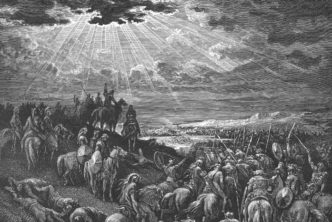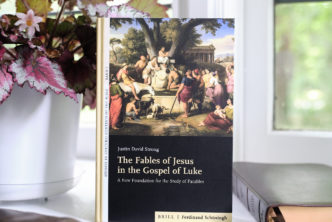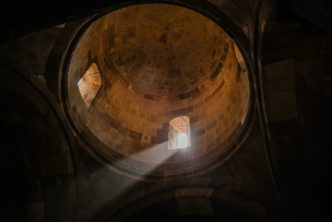
How can we define what is indefinable outside of itself? That is, how is the human mind able to consider a concept such as beauty, when it can only be known through mediums that are beautiful? In other words, is beauty an adjective, a noun, a Person? And what is our relation, as mortal humans, to a concept like beauty that lies outside the reach of time and death?
An example. That object on the table beside me is beautiful. I know this because other objects around it are not beautiful, or not as beautiful to my view as this one object. That music in my headphones, it sounds beautiful. Is that intrinsic to the music, or do I know that because other music is less beautiful, or slightly more so?
And if there are degrees of beauty, just as there are different contexts for beauty (art, music, people, landscapes, etc), how are they to be measured? Is beauty really only “in the eye of the beholder,” or is there some quality of beauty inherent to every singular object and person that all might agree is more or less in abundance in any given thing? If so, from where does this quality of beauty come?
How can we begin to measure beauty, in the truest sense of the word, but as the contrast and coupling of the innocent, the pure, and the unblemished, with that Source which exceeds it in every way? And what is the antithesis of beauty but all that diverges from this Source in any way?
If the Source is himself the origin of beauty, is he not also beauty itself? This being the case, my ability to access that beauty, to embrace the Source, is dependent upon one thing: the gift of faith. That same Being who spat in the eyes of a blind man so he could see (and the first thing he saw was the face of Beauty!), opens the eyes of all his children to see him who is beauty. David yearns to “gaze upon the beauty of the LORD” in his temple. Zion, that holy eschatological city, is “the perfection of beauty” (Ps 50:2). Moses, the greatest patriarch, begs that “the beauty of our Lord, our God, rest on us” (Ps 90.17).
Isaiah promises those who are faithful to the Lord that, “your eyes will behold the king in his beauty” (Isa 33:17). True beauty is seen only by the righteous, those of faith, for the King himself is Beauty.
Seeing beauty through the eyes of faith means a constant and cognizant practice of subsuming the exquisite aesthetic, moral, musical, and philosophical superiority of any single thing to that transcendent beauty of the One who created all things ex nihilo. To see beauty truly is thus a spiritual discipline, an act of worship, a posture of love.
We are so ready to speak of beautiful things in the world around us as “reflections” of God’s true beauty. We are so eager to use illustrations in our sermons and teaching about the “greater” beauty of Christ, in comparison with the most beautiful paintings, music, or people we have ever experienced. But these are not “mere” reflections, as commonly stated; actually, they are so much less than that.
Rather than reflecting Beauty, we must look at and listen to and feel every object of beauty as nothing more than imprints of divine creatio ex nihilo. The closest our minds can come to understanding this reality is the impress of fingerprints into soft clay. The light bounces across those clay fingerprints, creating shadow and contrast, highlight and color; but these are still only indents of Beauty unseen. Hence the beauty of the world around us is nothing less than the mark of the Creator left visible, in an act of grace, in the dark nightmare of futility in which we wander; and yet, we wander in hope (Rom 8:20).
And there indeed is the great irony: the greatest beauty we have yet to see is just that, something no one has seen, heard, tasted, or felt, but which stands ever before us as unseen hope (Rom 8:24-25).
Two analogies from art.
One: The music of Bach doesn’t simply pale to the music of heaven; the earth could not bear up under the resonant power of those as-yet-unheard chords. No, it would be ripped apart by their very vibrations in a blast of fleeting ecstasy. When we hear that music, then we will know true Beauty.
Two: The prose of Hugo doesn’t merely fade in the presence of Divine narrative; when Jesus sits upon the throne before his gathered elect and tells all, not just the pieces of his Incarnate life that cannot be contained in numberless books (John 21:25), but the whole of it, from before the world began to this present moment when you are sitting there listening to your Lord speak, his own audible voice entering your ears so long assaulted by the filth of a noisy world gone mad with its own self-devastating narcissistic fury, his own lips moving before your eyes transfixed upon this Being who narrated your life into existence with his Word; his nail-scarred and wood-calloused carpenter’s hands painting the air with every expression, even pointing momentarily at you. When you hear that prose, then you will know true Beauty.
Eugene Peterson paraphrased so eloquently this relationship of faith and beauty: “our lives filled up with light as we saw and understood God in the face of Christ, all bright and beautiful” (2 Cor 4:6). Paul, the apostle who lit the world on fire with a flame that still burns, pleads with the Corinthians to proclaim Jesus Christ, to proclaim Beauty.
If Christ is Beauty, this means, however, that my every effort as a scholar, a husband, a father, an artist and so much more must meet an impossible dual criteria: strive for beauty in all, yet acknowledge the ever non-beauty of all but Christ. My “output,” my “success,” my “achievement”, my very being, is revealed as “Non.” That is, all I do is non-beauty; I am Non-beauty, no matter the praise and adulation I receive from others, no matter the extent to which I adorn my body and my home. Beauty is Christ alone. We, all that we are and create, are Non relative to that one true Beauty.
And yet, there is a sense in which we participate in the Beauty who alters the trajectory of our Non. Indeed, “we all, who with unveiled faces contemplate the Lord’s glory, are being transformed into his image” (2 Cor 3:18). Such is the performance of Beauty, an act of creatio e contrario.
Questions arise.
How can anyone navigate that realm between their being as Non and that Beauty who is resurrected and ascended? How can Non-beauty approach Beauty Incarnate?
Rather than speak of “reflecting” the beauty of Christ, perhaps another analogy is appropriate. We, as believers, must exist in tension as we await the return of Beauty, like the fleeting moments between the notes. We are not the strings, we are not the fingers that move the keys, nor are we the hammers that strike the strings, nor the soundboard that projects the sound.
We are the silence of Beauty. We are the silence between the notes. A silence that is resonant with the whisper of a God who so often seems infinitely far from us, and for whose return we long and languish, and yet to whom we owe, first, our existence, and second, our participation in this transcendent resonant Beauty as Nons being remade beautiful.
To return to the question: how can we begin to measure beauty?
The answer: in a Word that proclaims its existence despite our inability to comprehend it, and a Spirit who opens our eyes to see a Light that our physical eyes cannot yet capture, that our physical brains cannot yet process. Herein lies the revelation and perception of this Beauty.
This is the Beauty who causes his Bride to tremble with desire.
This is the Beauty who transcends all human understandings of value and simply cannot be comprehended apart from his personal intervention.
This is the Beauty who transforms the most wretchedly ugly beast into the most lovely innocent child of his own initiative, under no compulsion but love and promise.
This is the Beauty who is so matchless and marvellous and magnificent that a word from his lips raises rotting corpses from the dust and clothes them anew with flesh and breath and life.
This is the Beauty of whom we write and preach and teach, and to whom we will answer (soon!), quivering before his brilliance, of our feeble attempts to articulate Him to a world bored with reading, to make Him known to a church tired of sermons, to force rough sketches of His image into the minds of students enraptured with Instagram. And still, like Paul, like the apostles and preachers and theologians long dead, we must yet proclaim Beauty.
The Editor
Note: this post was originally published on May 7, 2019 on the Logos Academic Blog.





[…] via Beauty, and its Non — theLAB […]
Very interesting, and my mind was drawn instantly to Isaiah 53.2 ‘For he grew up before him like a young plant, and like a root out of dry ground; he had no form or majesty that we should look at him, and no beauty that we should desire him.’ Sin disorients the mind from true beauty found in God, so we can not see nor appreciate true beauty because we fixate on the material outward beauty – a person or thing – and we finish up worshipping those.
My other instant thought was Jonathan Edwards, he wrote a lot about the beauty of Christ. For him the essence of a true religious experience is to be overwhelmed by the irresistible beauty of God. Regeneration was a kind of new way of “seeing” – seeing what was truly beautiful, Christ, holiness, etc. I think he wrote on this in The Nature of True Virtue or something like that.
Regarding your article and opinion piece “Covid the mark of the beast?”
The end of the world in Revelation in God’s Word starts with the opening of the first seal. A white horse goes forth conquering and to conquer. On the white horse is a rider. What is he carrying on the white horse that goes around the world, nation to nation, conquering and to conquer?
The rider is carrying a bow and a crown.
God translated His Word into English, so you can use a Strong’s Concordance to find the word it was translated from and the definition of the word before it was translated.
So a “bow” actually means “the simplest of fabric”. And you may know that there is another word for crown that means exactly the same thing. That word is corona.
So there is a white horse going around the world conquering and to conquer with the simplest of fabric and a corona.
Revelation 18:23 tells us ALL nations are deceived. By what? Sorceries.
When you look up sorceries in a Strong’s concordance it means “pharmakeia, pronounced far-mak-i’-ah. It means medication (“pharmacy”), that is, (by extension) magic (literal or figurative): – sorcery, witchcraft. A drug.
Wake up friend. Do you know what the snake bite is for?
This fed my heart and my mind. Is this an excerpt from a larger work? Who is the author? Thank you for the post.
Hi Nik, thanks for the comment. This is not (yet) part of a larger work, although I plan to write more on the topic in the coming years. The author is the managing editor of the blog, Tavis Bohlinger.
Thank you, Travis! I was wondering if it was you. I didn’t know if you primarily posted contributions from other authors, or if you also blessed us with your own work. It looks like you do both. I hope you do write more on this. I will be on the lookout.
Thanks, Nik! I published an earlier essay, “On the Life of the Mind,” here on theLAB, so you might want to check that out as well.
You comments on the concept of beauty, in my opinion, were comments on Biblical religious beauty, and more specifically, Christian beauty. There is no true concept of beauty in general -no universal. That need for a universal definition of beauty is a bad habit of academic thinking that creates philosophical problems. Rather, there are concepts of beauty set in contexts of life experience. You gave us some Biblical concepts of beauty tied with life in Christ, or, at least, in the fear of God, that we Christians can understand and feel the worship. But that might be dismissed by a non-believer as meaningless. Now, paradoxically, Kant’s Critique of Judgement is an analysis of beauty -in Kant’s language-in-general. Because he writes in general, and gives few examples, his language can be very opaque. But it’s worth the hard effort to master. He has had enormous influence on aesthetics in the arts. There are other writers, but Kant is the modern starting point on concepts of beauty.
Thanks for this comment, Robert. I admit that I need to read Kant. I would just point out, however, that my specific argument in the piece was that beauty is Christ, Christ is Beauty. I am not actually arguing for biblical or Christian beauty, as in, beauty with adjectives, but setting forth Christ as the source, the embodiment, and the definition of Beauty. I hope to expand on this more in a larger work. Until then, I’m happy to keep up the dialogue (especially once I get to Kant; give me until the Fall of this year).
I’ve heard it said that to be altogether holy is to be altogether beautiful, speaking of God of course. Although we can talk about them specifically, are they inseparable??
Other descriptions of God; God is light, God is love, God is spirit, God is a consuming fire. I believe the way these are taught in Scripture suggests these are not mere adjectives but point to His essence.
Thank you Tavis, I really enjoy your writings
Thanks, John.
[…] Beauty, and its Non […]